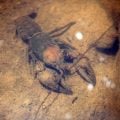Saltwater Utility Flies: “Anywhere, Anytime”

Dolphin feeding grounds are often a short run from bonefish flats. Some miscellaneous flies stashed in your tackle bag will equip you for shots at these hard-fighting fish.
MY RITUAL of always carrying what I call the Miscellaneous Fly Box (MFB) began out of fear. A few years back, after returning from a trip to Alaska, I had only a couple of days to turn around and pack for a bonefish trip to Belize. By departure day, I was running late, rushing out the door when my wife, Marilyn, asked if I had everything.
“Yeah, yeah, yeah,” I was saying, just as the phone rang. It was a friend who was coming on the same trip, calling to remind me to take the special bonefish flies — the ones with the rubber-band bodies — he had tied for me.
Then and there I realized that not only had I not packed the rubber-band-body bonefish flies, but I hadn’t packed any bonefish flies at all. I still had my Alaska flies and wondered how a bonefish would react to a large Egg Sucking Leech. It would have been a bad trip.
So, since that time I now take with me a general fly box with a few of everything, from bonefish to billfish patterns. It might sound silly, but the box lives in my tackle bag. It’s my security blanket. And it has paid off.
One year, while bonefishing with a friend at a camp in Grand Bahamas, we found a school of big horse-eye jacks pushing bait toward the edge of a narrow flat adjacent to deep water. We approached the feeding fish and cast our biggest bonefish flies, probably size 2s, with no results. The jacks were feeding on much larger bait. But I remembered my MFB and realized that I had large poppers with me. The jacks took those poppers with gusto, and soon I was tied to one. Wouldn’t you know it, my friend wanted a popper, too.
I handed him one of my poppers and asked, “Do you know what the going ‘field price’ is for a big popper during a jack feeding frenzy?” He paid for drinks that night, and he was rigged with a popper the next day.
In the years since I started carrying the MFB, I have also taken quite a few dolphin during bonefish trips. Really. On several occasions, I have made a quick run from an outside flat to the edge of the ocean and found dolphin on the closest weed patch. If you keep your eyes open, you never know. My son, Stephen, once took a 40-pound dolphin on a big bucktail he tied while fishing out of the famous Peace and Plenty Bonefish Camp — all because we had the proper flies.
Then there was the fishing trip with two other friends to northern Key Largo for bonefish, during which we decided that since it was only going to be a half-day in the afternoon, we needed only a couple of bonefish flies. So I left my tackle bag at home. The afternoon was flat, calm, and hot. We hadn’t poled the boat very far before we saw several large fins showing at the edge of the flat against a channel. Before we knew it, we had four big tarpon swimming within 40 feet of the skiff. And, if I recall correctly, we had size 4 Bonefish Specials and a couple of Clousers.
The tarpon did not even look at our flies, of course, but they didn’t spook, either. I would not have minded if they had spooked. I can take a spook. Or it would have been fine if they followed a fly and rejected it. I can live with that. But instead, without showing any fear, they just ignored us. That hurts. I think they knew we had no tarpon flies.
Don’t forget that bonefish destinations, such as the Florida Keys, the Yucatan Peninsula, and Belize, are only minutes by boat from the brackish-water world of snook, tarpon, and more. A utility fly box can save your trip or add to it by allowing more options.
The MFB Arsenal
While I’m always changing, adding, and deleting flies from this box, and often trying new patterns, the basic concept remains. Here goes:
1. Include at least a half-dozen bonefish flies: Clousers, Bonefish Specials, small size 4 crab flies, and maybe a shrimp pattern or two. Bonefish flies often work well on finicky, backwater reds. And they often take small tarpon patterns when other flies fail.
2. Pack several permit crabs. Not only are they great for permit, but I also have used these crabs to take big tripletail when they would not bite anything else.
3. Who can resist casting to a big shark in a few inches of water? Pack a couple of orange shark flies. And maybe throw in a whiteand-green fly â?? you can cast this in very clear water when the sharks may not take orange, or cast it to any other species of big fish.
4. Pack a few poppers in sizes 1 to 2/0. These are not just for jacks; often a hard-to-feed barracuda
will come up to a popper and explode on it. And when that happens, you won’t forget the strike. I guarantee it!
5. Stash a basic 6-inch fly and also a 10-inch pattern for a really big ‘cuda. Your standard ‘cuda fly is fine, but often a really big fish needs a large, long, bright-green fly.
6. Backcountry snook, redfish, baby tarpon, and big tarpon will fall for Sea-Ducers, large Clousers, and Crystal Shrimp. Incidentally, a yellow-and-red Sea-Ducer is one of the best dolphin flies I have ever used.
7. Expand your depth with weighted flies in sizes 1 and 2/0. You’ll need these especially in remote fishing camps, where the edges of the flats and channels have endless fishing possibilities. With the use of a sinking fly line, the variety and size of fish you could take are endless.
Depending on the type of trip and the tackle bag I decide to take, I have two ways to carry the miscellaneous group of flies mentioned here. If I have ample room, I usually use a large plastic box. If space is at a premium, I put the different flies in small plastic bags and then put the small bags in a larger ziplock bag. This way they take up relatively little space.
Other than to cover me when I forget something, the MFB is there so I can take larger fish, probably of a different species than what I normally am targeting. So I always make sure, whether bonefishing or fishing for reds, that I bring a 9- or a 10-weight rod.
These midsize saltwater fly rods are powerful enough to take a shark over 100 pounds, a large barracuda, a big jack, or a variety of deepwater species. The gear is also the ideal size for barracudas and permit on the flats or midsize tarpon — many tarpon above 100 pounds are taken every year with 9- and 10-weight rods.
All the flies in the world will not help you if a big ‘cuda appears while you are bonefishing and you are not rigged properly. And a school of jacks feeding on bait is not a sight that will last very long. So you’ve got to be ready.
The easiest and most flexible way to rig is to take that 9- or 10-weight line, attach a long 5- or 6-foot butt section, and put a loop at the end. (I often use a Duncan loop for this.) Then, after having a conference with my guide, preferably the night before, we decide what are the most probable fish or conditions we may encounter besides the expected conditions for bonefish or redfish — or whatever you’re fishing for.
Let’s just say that because of the warm weather the guide decides you are more likely to see permit than barracuda. Then I rig the rod by looping on a 12-pound tippet and tying on a permit crab. But, back in the MFB, I will still have a ‘cuda or a shark fly rigged with wire, and maybe a popper with a mono shock tippet for big jacks. Now I can loop and unloop a variety of rigged flies in a few seconds, and take advantage of some of those really exciting moments that often happen while flats fishing but that almost never last long.
When the possibility of seeing more than one large species of fish is very good — say, permit and barracuda on a bonefish flat or tarpon and sharks on a backcountry redfish flat — I simply rig two rods. Maybe a 9 and a 10. Now you may not want to buy or bring that many rods, but I just want you to know that I often have rigged and ready more than just a couple of rods. On some occasions, I may have a light bonefish rod, a heavier bonefish rod with a weighted fly, a permit rod with a crab, and an 11weight tarpon or shark rod. It may seem like too many to you, but I often do really well just because I’m prepared. And in the case of a rod breakage in a remote camp, I’ve got spares.
These days there are certain items that never leave my tackle bag, such as forceps, clippers, a rigging kit, and more. The large MFB is one of them. It lives, as you face the bag, at the end of the northwest corner, bottom layer. It’s there right now.
If you travel to different destinations for flats fishing, sooner or later you are going to need spare flies. You will have either forgotten to bring the right patterns or you’ll find yourself face-to-face with a large fish you did not expect to find. Will you come out of the encounter with a story or a photograph? It’s your choice.











